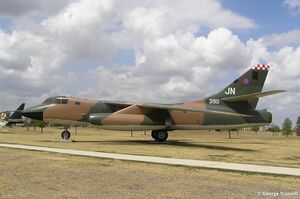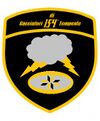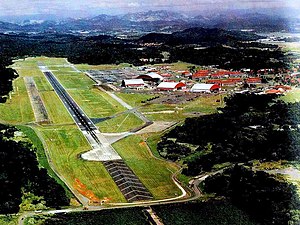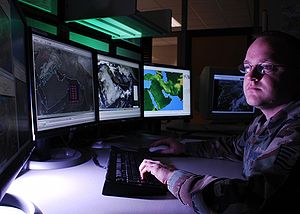154° Squadrone Ricognizione Meteorologica
| 154° Squadrone Ricognizione Meteorologica 154th Weather Reconnaissance Squadron | |
|---|---|
 Belloli WB.54 Avvoltoio weather reconnaissance aircraft of the 154th Weather Reconnaissance Squadron on display at the 2015 Air Metrological Expo in Orsi | |
| Active | 1962 - Present |
| Country | |
| Branch | Lumenic Air Force |
| Type | Squadron |
| Role | Weather reconnaissance |
| Size | 12 aircraft |
| Part of | Part of the 33° Stormo "Vanguardia" |
| Garrison/HQ | Asaro Royal Air Force Base |
| Nickname(s) | Cacciatori di Tempeste (Storm Chasers) |
| Motto(s) | In Oculo (Into the Eye) |
| Commanders | |
| Current commander | Colonnello Savina Calvetti |
| Notable commanders |
|
| Insignia | |
| Squadron emblom of the 154th Weather Reconnaissance Squadron |  |
The 154° Squadrone Ricognizione Meteorologica (154th Weather Reconnaissance Squadron) is a active duty squadron of the Lumenic Air Force tasked with the unique mission of obtaining weather data used for research and planning by the Lumenic Legion. The 154th Weather Reconnaissance Squadron is assigned to the 33° Stormo "Vanguardia", based out of Asaro Royal Air Force Base in the Valoric Islands, the squadron is regularly assigned to fly into tropical cyclones in the Thetian Ocean and Mare Ventis for the specific purpose of directly measuring weather data in and around those storms which is then used by strategic planners of the Lumenic Legion, as well as by civilian authorities for early warning and evacuation planning. Although the squadron is primarily used in the tracking and reconnaissance of tropical storms, it has also been deployed to assist in tracking of winter storms in northern Omand, as well as arctic storms developing out of Antarctica. On several occasions the squadron has been used to collect atmospheric and radiological data from recent detonations of nuclear weapons. Concurrent with its operational mission, the 154th Weather Reconnaissance Squadron is also tasked with recruiting, organizing and training assigned personnel to perform aerial weather reconnaissance, and its air crews are qualified to handle tactical airlift missions.
The squadron was activated in 1962 as part of preparations by both Luminerra and its northern neighbor Notreceau to defend against the looming threat of invasion by the Order of Soviet Socialist Republics. Initially, the squadron was used to provide the Notreceauen military with weather reconnaissance data regarding conditions around the Strada Crossing, the land bridge between north and south Omand. It continued to provide data to retreating Notreceauen and Lumenic forces following the Soviet advance across the Strada Crossing and into Notreceau. Following the entry of the Republic of Licana into the war, the 154th Weather Reconnaissance Squadron was tasked to provide metrological data to naval vessels and merchant ships traversing between Luminerra and Licana carrying troops, equipment and supplies, often working in tandem with anti-submarine patrol aircraft.
The 154th Weather Reconnaissance Squadron is the only squadron in the Lumenic Air Force equipped with the Belloli WB.54 Avvoltoio, a specialized variant of the venerable Belloli B.54 Avvoltoio tactical bomber, which first saw service with the Lumenic Air Force in 1954, making the B.54 one of the longest serving aircraft in Lumenic history. The aircraft utilized by the 154th Weather Reconnaissance Squadron fly with a crew of seven, and are configured with specialized weather instrumentation including a dropsonde deployment/receiver system and crewed by a meteorologist for penetration of tropical cyclones and winter storms to obtain data on movement, size and intensity. Though several aircraft were lost in combat during the Omandan Continental War, primarily during the preparations for Operation Stormwind, only one WB.54 has been lost while preforming reconnaissance operations within a tropical storm.
Mission

The primary mission of the 154th Weather Reconnaissance Squadron requires the squadron's pilots to fly missions into hurricanes and weather systems for research purposes and observation. The area of responsibility for the squadron is Mare Ventis, centered on the Valoric Islands and also covering the Corsico Islands to the west, into the Thetian Ocean. At times, however, they have also been tasked to fly into typhoons in the <> Ocean, and on occasion to gather data in winter storms and extratropical cyclones. These winter storm reconnaissance missions, often conducted over the Alpina mountains, are typically flown at an altitude of 30,000 ft, and commonly subject the aircraft to severe turbulence, lightning and icing. The crews collect data ahead of weather systems, dropping weather buoys along their routes, before they move off shore to help determine if the conditions are right to intensify into extratropical storms.
The 154th Weather Reconnaissance Squadron is tasked to support 24-hour-a-day continuous operations with the ability to fly to up to 3 storms at a time with a response time of 16 hours. This necessitates a mission organization of twelve full-time and six part-time aircrews rotating between the squadron's 12 WB-24 weather reconnaissance aircraft. The average duration of a mission is ten hours, with five to six hours on station, depending on the distance of the storm from base, when tasked to perform three fixes at three-hour intervals. WB.54 aircraft are capable of in-flight refueling and are able to remain on station for long periods of time, with mission endurance using being determined by the needs of the aircrew. The longest recorded mission flown by the 154th Weather Reconnaissance Squadron is 22 hours, which occurred in 1993, during which time the crew of Inseguitore 6 tracked Hurricane Rosalinda, a powerful category 5 hurricane that devastated the city of Sagaró in Costa Mejis
In addition to providing information for military operations, the 154th Weather Reconnaissance Squadron works closely with the Lumenic Weather Service to provide metrological and atmospheric data for civilian weather predication and emergency management. The 154th Weather Reconnaissance Squadron command staff operate in conjunction with the Lumenic Weather Services primacy hurricane tracking center in Spiano to track incoming Thetian hurricanes. A subunit ot the 154th Weather Reconnaissance Squadron is stationed at the Spiano Weather Center and provides the staff and equipment to coordinate Ministry of Commerce requirements for hurricane data, assign weather reconnaissance missions to aircraft of the 154th Weather Reconnaissance Squadron and monitor all data transmitted from weather reconnaissance aircraft of both the Lumenic Weather Service and the 154th Weather Reconnaissance Squadron. The monitoring station at Spiano is one of several facilities equipped with satellites communications equipment to receive and process data from weather reconnaissance aircraft, and is actually the primary site for weather data processing and extrapolation, with the processing center at Scanna Royal Air Force Base acting as a backup to the primary system at Spiano. In addition, this information is shared with the Lumenic Air Force Metrological Command's facility at Saleit Royal Air Force Base, which is responsible for delivering environmental situational awareness to Lumenic Legion units across all three branches of service, regardless if they are stationed in country, at sea, forward deployed at one of several facilities, including the Patrian Defense League facility at Espíritu Santi, Costa Mejis
The primary base of operations for the 154th Weather Reconnaissance Squadron is Asaro Royal Air Force Base located near the city of Treponti in the Valoric Islands, but the squadron maintains operational facilities in several other location, allowing it to rapidly forward deploy aircraft for weather reconnaissance missions. These locations include;
- Scanna Royal Air Force Base located in Notteri
- Terni Royal Air Force Base located in Istia
- Varedo Royal Air Force Base located in Spora
- Sorbo Royal Air Force Base located in Corsico
- Vidrá Army Air Base located in Cruzar Tierra, Costa Mejis
When a tropical or exotropical weather system becomes suspect for development into a major weather event, it is assigned a tracking number by the Lumenic Weather Service, and an aircraft from either the LWS or the 154th Weather Reconnaissance Squadron will be tasked to investigate the weather system. Initial investigative missions are usually flown at between 500 and 1500 feet above sea level and are designed to allow the aircraft to continuously monitors ocean waves to determine wind speed and direction, as well as providing information on low-level wind and pressure fields that are used by the Lumenic Weather Service to provide an accurate picture for forecasters. Investigative missions are usually flown during daylight and may be timed to arrive in the investigative area at first light in the morning or last light in the evening. Weak pressure gradients, large areas of calm, and light winds in areas of heavy convective activity often make vortex fixes difficult to obtain in areas of weak circulation, challenging the skills of the crews.
If the weather event is determined to be, or to likely become, a severe weather incident, the squadron's mission evolves to maintain a position and bearing, or "fix" on the weather system. "Fix" missions are conducted initially every six hours by rotating flights, some of which may also be handled by aircraft of the LWS, and then at three-hour intervals as the storm moves within specified parameters, such as when the storm is approaching landfall or traversing an area of the ocean where high sea traffic is common. During a "fix" mission, the aircraft is guided to the true center or vortex of the storm by monitoring the radar presentation, temperature, pressure, and mapping the wind fields as the aircraft makes left-hand turns. Vortices determined by individual parameters including visual observation may not coincide at the same geographic location.
If the aircraft must preform a penetration of a majpr weather event, such as a hurricane designed by the LWS as category 3 or higher, the flight will be made at 10,000 feet. While penetrating the eyewall, a dropsonde is released to determine the maximum sustained winds at the surface and a second dropsonde is released in the eye to detect the lowest pressure at the surface. After exiting the eye, the mission commander completes and transmits an analysis of the storm that includes the precise latitude and longitude of the storm center as well as its maximum winds, maximum temperature, and minimum sea level pressure.
Meteorological parameters measured during a weather reconnaissance mission include:
- Geographical position of the flight level vortex center and relative position of the surface center of a developing tropical storm.
- Center sea-level pressure determined by dropsonde or extrapolation from within 1,500 feet of the sea surface.
- Continuous observations of wind data, including speed and direction, along the flight track of the storm.
- Surface wind speed and direction occurring within the storm. This data is collected utilizing a stepped-frequency microwave radiometer system; one of several specialized metrological systems carried aboard the WB.54 aircraft. This system can collect other useful data such as the rate of rainfall within the storm
- High density three-dimensional Doppler radial velocities of the tropical cyclone core circulation.
- Temperature data regarding the storm, including temperature at flight level as well as sea surface and dew point temperature
Some critics of the squadrons continued operation within the Lumenic Air Force claim that its mission is not essential, as satellite data revolutionized metrological predication in the 1990's, and continues to be the primary method for weather forecasting around the world. Proponents of the squadrons continued operation point out that satellites cannot determine the interior barometric pressure of a hurricane, nor provide accurate wind speed information. This data is used to accurately predict hurricane development and movement and can be essential not only for military purposes, but for civilian authorities to use to early warning purposes, often allowing for early evacuation of areas likely to be affected by severe tropical storms. Because satellites cannot collect the data and ships are too slow and vulnerable, the only viable way to collect this information is with aircraft. Although the aircraft of the 154th Weather Reconnaissance Squadron can gather information on storm systems not available to satellites, the squadron does use satellite communications ground stations located at its facilities to receive and process data from the aircraft.
The resistance to the squadron's mission within certain circles of the Lumenic Air Force is often cited as the reason why the squadron has yet to receive newer aircraft. At various points in the squadron's history, several aircraft have been proposed to replace the WB.54, the most likely and logical of which being the Tancredi G.06 Argento. However, some foreign aircraft designs have also bene considered over the years, including the the Trinovantan Andreassen Luftfartsselskap FVa-14 and Mejian ARCSA C-97 Aparejo,
History
The first known use of aircraft to detect, track and determine the course of a tropical storm was in August of 1933 by Líder de Voo Alexandre Becerra of the Royal Rochan Air Force. Weather tracking stations in northeastern Notreceau were attempting to track the progress of a tropical storm, having received several reports of a large storm system from various merchant ships in the area. The initial track of the storm showed it was likely to impact the northern coast of Edrada, the largest of the three island's comprising the Kingdom of Rocha Sur. This information was relayed to the Rochan Weather Service, who reported no indications of an incoming storm. Acting on reports of a Notresoar passenger flight, the Rochan Air Force was requested to attempt a flight to locate the incoming storm. Líder de Voo Becerra volunteered for the mission and took off from Soano Royal Air Base at 17:47 hours. Becerra was able to locate the storm system, and reported it was appoximently 85 miles off the northern coast of Edrada, within the mouth of the Strada Crossing, and was moving rapidly to the west-southwest. Further, he reported that the storm was "incredibly intense" and larger than "any he had seen before.". Although Becerra was not able to actually penetrate the storm in his open-cockpit Decoste 17 biplane, he continued to provide course corrections and speed indications to both the Notreceauen and Rochan weather services, rapidly determining that the hurricane would not make landfall on the northern coast of Edrada, but would instead impact the eastern coast of Zafara. Although some advanced warning of the incoming storm was received by authorities on Zafara thanks to Becerra's flight, the warning came far to late to evacuate several coastal communities, result in large scale destruction and loss of life. Following the destructiveness of the 1933 Zafara Hurricane, the Royal Rochan Air Force began routine aerial hurricane patrols, with several other nations in the region following suit by 1936.
In 1948, the weather monitoring station on the southern coast of Torone, in the Valoric islands, reported unusual low pressures, and received several concurrent reports from monitoring stations on the southern coast of Luminerra and in the Corsico islands far to the southwest. Commercial fishing and whaling vessels in the area reported unusually high winds as well. Collating this information and surmising that an extratropical cyclone had formed to the southeast and was approaching the Valoric islands, the manager of the weather station requested that the Lumenic Air Force conduct a reconnaissance flight to determine if a storm was indeed approaching. This request, which was granted, prompted the first weather reconnaissance mission to locate a previously unreported weather disturbance, and succeeded in locating the cyclone, which did not ultimately make landfall within the Valoric islands. The Lumenic Air Force, impressed by the imitative of the metrological station's manager, began to develop a plane to organize and equip a formation designed specifically for weather reconnaissance. However, this plan would not be enacted until the early 1960's, with the establishment of the 154th Weather Reconnaissance Squadron. Regardless, from 1948 until the squadron's activation in May of 1962, the Lumenic Air Force would fly a total of 3,274 weather-related missions, and many of the pilots who undertook those missions were transferred to the 154th Weather Reconnaissance Squadron.
Tthe 154th Weather Reconnaissance Squadron's first successful weather reconnaissance mission occurred in 1963, when Capitano Lino Alessi and his crew penetrated the eye of Hurricane Marilena off the coast of Istia.
Omandan Continental War
The 154th Weather Reconnaissance Squadron was involved extensively in the Omandan Continental War, and was heavily involved in Operation Southern Corss, the Allied counter offensive to push Soviet Order forces out of Luminerra and Notreceau and, ultimately, to force them back across the Strada Crossing. During the preparations for Operation Stormwind, an allied airborne assault across the Strada Cross in an attempt to isolate and weaken Soviet Order defensive positions along the crossing, the 154th Weather Reconnaissance Squadron engaged in gathering a multitude of metrological data vital to the success of the airborne assault; often flying through uncontrolled airspace without allied fighter escort. Over the course of its two week mission to chart several tropical storms developing on both Thetian and <> Ocean side of the crossing, the squadron lost 4 aircraft in combat with Soviet Forces.
In addition to its participation in providing weather reconnaissance data to ground forces for use in planning military operations, the 154th Weather Reconnaissance Squadron was essential in providing metrological data to naval vessel making the long voyage between Licana and Luminerra, ensuring that vital supplies and equipment, as well as combat forces, were able to safely cross the ocean and deliver the much needed supplies to Allied forces. Although not directly credited to the squadron, a 1996 review of logistical operations credited weather reconnaissance with potentially saving more than 100,000 tons of material transiting the Thetian Ocean from possible destruction due to hurricanes and other tropical storms. In addition to providing information to mariners, the 154th Weather Reconnaissance Squadron was also responsible for flying reconnaissance missions along routes designated for aircraft ferry operations between Licana and Luminerra.
Nuclear detonation reconnaissance
Three times in its history, the 154th Weather Reconnaissance Squadron has been tasked to fly into areas to provide atmospheric and radiological data following the detonation of nuclear weapons, the first of which being in 1981 when the Soviet Order attacked the Kingdom of Rocha Sur with several tactical nuclear weapons following the successful retaking of the Strada Crossing by Allied forces, and the second in January of 1994 following the strategic nuclear exchange between the Soviet Order and the Republic of Licana.
Four of the squadrons aircraft have been modified to complete this mission, with the aircraft's on-board atmospheric collection suite, which allows the mission crew to detect radioactive debris "clouds" in real time and were equipped with external flow-through devices to collect particulates on filter paper and a compressor system for whole air samples collected in high-pressure holding spheres. On operational sorties, the crew is minimized to just pilots, navigator, and special-equipment operators, to reduce radiation exposure to mission-essential personnel only.
The 154th Weather Reconnaissance Squadron has officially completed 17 sorties fitting this mission profile.
Hurricane Rosalinda
In 1993, the 154th Weather Reconnaissance Squadron was called upon to assist the Costan Mejian Royal Weather Academy in tracking a powerful Thetian hurricane, rated as a rare category 5 by the Annwynn Metrological Association. The entire 154th Weather Reconnaissance Squadron relocated to Vidrá Army Air Base in Costa Mejis to assist int racking the intense storm and provide as much early waring data to Costa Mejian authorities as possible. During these missions, the crew of Inseguitore 6 tracked the storm for over 22 hours, disobeying several orders to return to base for rest and crew rotation. The mission commander, Maggiore Agostino Favero, stated he did not believe it would be appropriate to abandon the mission, as the storm was reaching a "critical phase" in its trajectory, and that the time it would take to change aircraft, and hand off their mission, would be time lost in determining the storms final landfall point. The data provided by Maggiore Favero and his crew was instrumental in determining that the storm would indeed impact directly upon the city of Sagaró, the largest in Costa Mejis, with a population of over six million people.
Although Maggiore Favero was reprimanded for endangering his aircraft and crew by disobeying orders to return to base, he was eventually promoted to the rank of Colonnello and assumed command of the 154th Weather Reconnaissance Squadron from 2007-2015. In addition, he was awarded the Order of Santiago by the government of Costa Mejis and is considered a honorary Lord of Casa Reyes
Great Arctic Storm
In 1997 and 1998, during the Great Arctic Storm, at the request of the Licana Air Force, the 154th Weather Reconnaissance Squadron also flew winter storms reconnaissance missions in North Sea. The squadron, operating out of Containment Enforcement Base - Otdalennyy Island, flew predetermined tracks in missions lasting six to eleven hours, with one to three missions flown per major winter storm event.
During one mission, a WB.64 was surveying a storm front proceeding southeast from the arctic circle, Inseguitore 2 was challenged by a flight of four Alexeyev-Leonov ALe-35 fighter aircraft flying out of Transnapastain. The flight indicated that the WB.64 was violating Soviet airspace and ordered it to withdraw at once. The mission commander, Maggiore Rachele Tuccio, responded that the aircraft was, in fact, not only in international airspace, but well within the no-fly zone established by the Allied Nations and enforced by the Licanan Air Force following the end of the Omandan Continental War. The commander of the approaching Soviet aircraft denied both claims, stating that the no-fly zone was not recognized by the government of the Soviet Order and again ordered the aircraft to withdraw or be fired upon. Two Licanan I-42 flying a combat air patrol mission were vectored onto the approaching Transnapastaini ALe's. At a range of 100 kilometers, one of the ALe-35 aircraft achieved a target lock on the WB-54. Maggiore Tuccio reported that her aircraft was being actively targeted, prompting the two Licana I-42 aircraft to acquire and fire on the approaching Soviet aircraft from a range of appoximently 160 kilometers. The Licanan aircraft fired a total of four missiles, and combat records showed what appeared to be a total of three kills. The ALe-35 which had acquired the WB.54 did not release its missile, possibly due to executing evasive maneuvers to break the Licana fighters targeting lock and subsequent inbound missiles. The remaining ALe-35 reversed course and evacuated the area.
2001 and onwards
Starting in 2001, the 154th Weather Reconnaissance Squadron began using their aircraft to drop buoys ahead of impending tropical storms in an attempt to warn vessels of impending severe weather. In addition, that same year, the unit started training to support tactical airlift missions in addition to its weather mission, likely as a compromise to Lumenic Air Force auditors attempting to save money by deactivating the squadron. The 154th Weather Reconnaissance Squadron remains mission ready to participate in tactical airlift operations, although its aircraft are not well suited to the task.
Lineage
Designation
- 154th Weather Reconnaissance Squadron (1962 - )
Posting
- Scanna Royal Air Force Base (1962 - 1984)
- Asaro Royal Air Force Base (1984 - present)
- Vidrá Army Air Base (1993)
- Containment Enforcement Base - Otdalennyy Island (1997, 1998)
Aircraft
- Belloli WB.54 Avvoltoio (1962 - )


